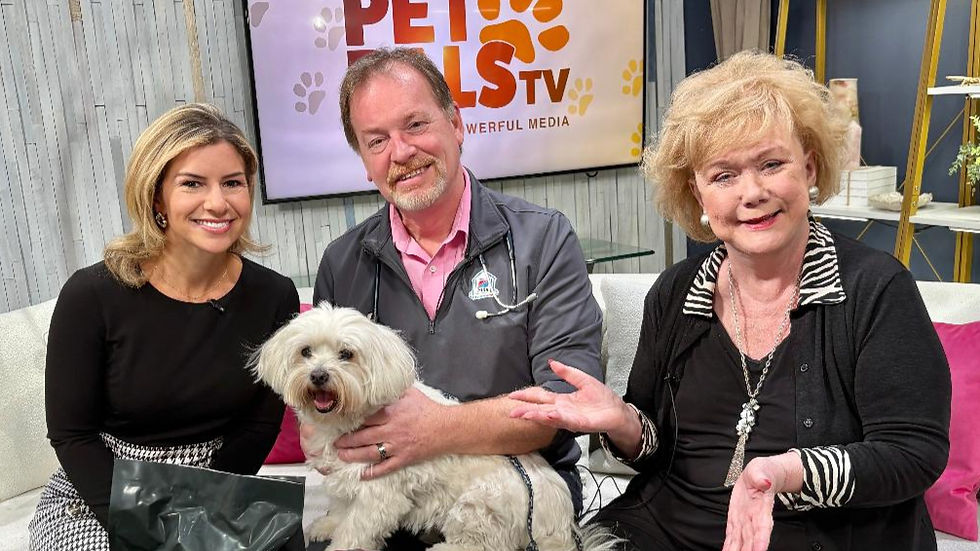Keeping Pets Safe During Holidays, Part 2
- Tom Dock, Noah's Animal Hospitals

- Dec 7, 2018
- 3 min read

About 3 weeks ago, just before Thanksgiving, I spent some time discussing how our holiday food favorites can be problematic for our pets. Today, it's time to take a look around the rest of the house!
Holiday decorations certainly need our attention! From the tree to plants to ornaments, each one has a possibility of danger. Glass ornaments can sparkle and reflect light, mimicking the movement of prey...and this is an irresistible lure for cats! Ever wonder why there are so many social media memes about keeping Christmas trees safe from pets? I am pretty sure that our feline friends are the overwhelming reason for trees in cages, trees on walls and the newly popular, "Half Tree". In any event, those glass ornaments can break, leaving little shards of sharpness waiting for naked toes or delicate kitty paws.
Tinsel and garland are extremely dangerous for cats as the string like structure again mimics prey. It's very easy for a cat to swallow a piece of tinsel and end up with a linear foreign body. Spending the holiday in an animal emergency hospital is no one's idea of fun, so keep the kitty away from the tree or avoid these types of decorations.
They are certainly pretty, but snow globes contain a type of antifreeze. While this is not problematic for most situations, if a curious cat or toddler knocks one off the mantle, you will want to get this mess cleaned up as soon as possible.

Many people worry about holiday ornamental plants. Urban myth has poinsettias as listed as deadly to pets, but in reality, these decorative favorites don't cause too many issues. Poinsettias have a milky white sap that could cause mild vomiting, diarrhea and drooling, but overall, it’s a fairly safe plant. More concerning plants include live mistletoe and holly. Both have the potential to cause vomiting and diarrhea, but mistletoe, in large amounts and the European variety, can cause cardiovascular issues and/or neurological signs. Thankfully, most pets won’t eat that much and we don't tend to see these used decoratively much here in the US.
In general, lilies are more of a problem closer to Easter, but cat owners should be aware that many types lilies are deadly to their feline friends! It only takes a leaf or two, or in some cases, just the pollen to put a cat into kidney failure! If you are sending floral arrangements to friends with cats, make sure the florist keeps lilies out of the bouquet!
Antifreeze is a common and deadly pet poisoning during colder months. Antifreeze has a sweet taste to pets, so they will readily lap up any spilled material. If you spill antifreeze, dilute the area well with water and sweep excess water into a rocky or sandy area. Cover area with soil to keep pets from licking at the rocks. If you suspect your pet has consumed any antifreeze at all, you must contact your veterinarian immediately! Ingestion of two teaspoons is lethal to cats and 2 tablespoons will kill a 40-50 lb dog!
There are "pet safe" antifreeze products that contain a bittering agent to help deter a pet from ingesting the toxin, but, as many dog owners have discovered, there are some pets that will lap up almost anything. Be safe and keep an eye on your pets when they are outside and clean up spills immediately
Ice melts are also a concern. In most cases, simply brushing the salt off your pet’s feet will be enough, but there are rare cases where dogs might eat enough of the product to cause salt poisoning. Like antifreeze, pet “safer” products are available but still have the potential for danger.
We want you to enjoy the fun activities during the cold weather with your pets, but just make sure to keep an eye open for the few things we listed above!! And keep your veterinarian's number and the closest animal ER's number handy!!
Got pics of your pets enjoying the cold weather? Or, maybe pictures where pets DON'T want to go outside? We would love to see them!!










Comments